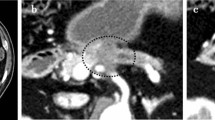Abstract
A 52-year-old woman was treated for a splenic aneurysm that was found on abdominal computed tomography (CT) during a preoperative assessment for rectal cancer. The aneurysm was embolized using the “double coil-delivered microcatheter technique,” and 4 ml of a mixture of N-butyl 2-cyanoacrylate (NBCA) and iodized oil (Lipiodol) (NBCA/Lipiodol = 1.0: 2.5) were injected into the aneurysm. The patient complained of left upper quadrant abdominal pain immediately after the procedure. A blood test 2 days after the procedure showed an increased white blood cell count (13 100/μl), C-reactive protein (13.36 mg/dl), and pancreatic amylase (428 U/l). Abdominal CT scan showed a huge cystic lesion at the pancreatic tail, in the center of which was a highly enhanced area due to accumulated NBCA-Lipiodol. Postembolization pancreatitis was diagnosed, and treatment with fasting and a drip infusion of nafamostat mesilate was started. The patient’s abdominal pain became less severe within 3 days, and the pancreatic enzyme level had normalized 14 days after treatment. On CT, the cystic lesion at the pancreatic tail was smaller 20 days after the procedure, and it had disappeared completely 75 days after the procedure.
Similar content being viewed by others
References
Nakahara T, Kutsuna M, Yamanaka M, Sakod K. Coil embolization of a large, wide-necked aneurysm using a double coil delivered microcatheter technique in combination with a balloon-assisted technique. Neurol Res 1999;21:324–326.
Guillon R, Garcier JM, Abergel A, Mofid R, Garcia V, Chahid T, et al. Management of splenic artery aneurysms and false aneurysms with endovascular treatment in 12 patients. Cardiovasc Intervent Radiol 2003;26:256–260.
Hope JK, Byrne JV, Molyneux AJ. Factors influencing successful angiographic occlusion of aneurysms treated by coil embolization. AJNR Am J Neuroradiol 1999;20:391–399.
Ekeh AP, McCarthy MC, Woods RJ, Haley E. Complications arising from splenic embolization after blunt splenic trauma. Am J Surg 2005;189:335–339.
Piffaretti G, Tozzi M, Lomazzi C, Rivolta N, Riva F, Caronno R, et al. Splenic artery aneurysms: postembolization syndrome and surgical complications. Am J Surg 2007;193:166–170.
Hamers RL, Van Den Berg FG., Groeneveld AB. Acute necrotizing pancreatitis following inadvertent extensive splenic artery embolisation for trauma. Br J Radiol 2009;82:e11–e14.
Wang YM, Cheng LF, Li N. Histopathological study of vascular changes after intra-arterial and intravenous injection of N-butyl-2-cyanoacrylate. Chin J Dig Dis 2006;7:175–179.
Andreou A, Ioannidis I, Nasis N. Transarterial balloon-assisted glue embolization of high-flow arteriovenous fistulas. Neuroradiology 2008;50:267–272.
Author information
Authors and Affiliations
Corresponding author
About this article
Cite this article
Tokuda, T., Tanigawa, N., Kariya, S. et al. Pancreatitis after transcatheter embolization of a splenic aneurysm. Jpn J Radiol 28, 239–242 (2010). https://doi.org/10.1007/s11604-009-0409-1
Received:
Accepted:
Published:
Issue Date:
DOI: https://doi.org/10.1007/s11604-009-0409-1




